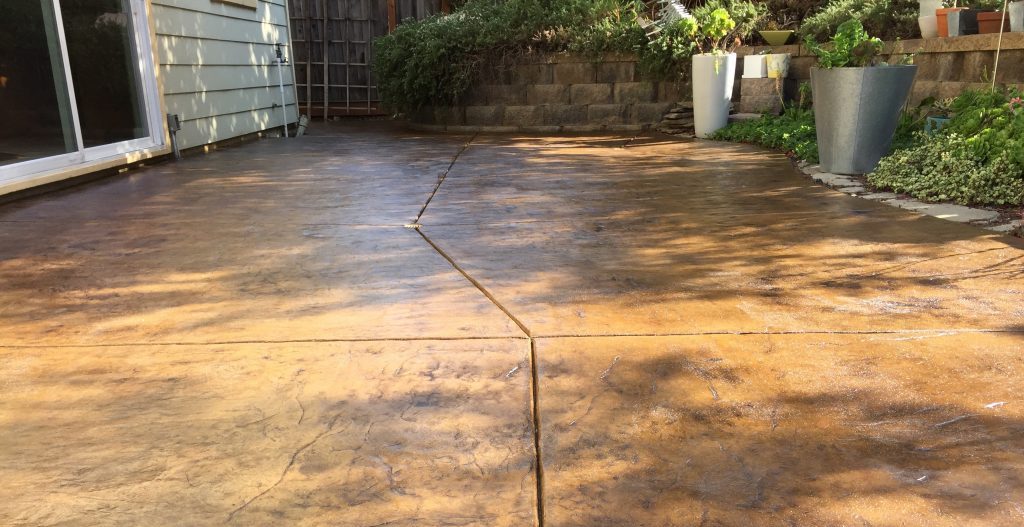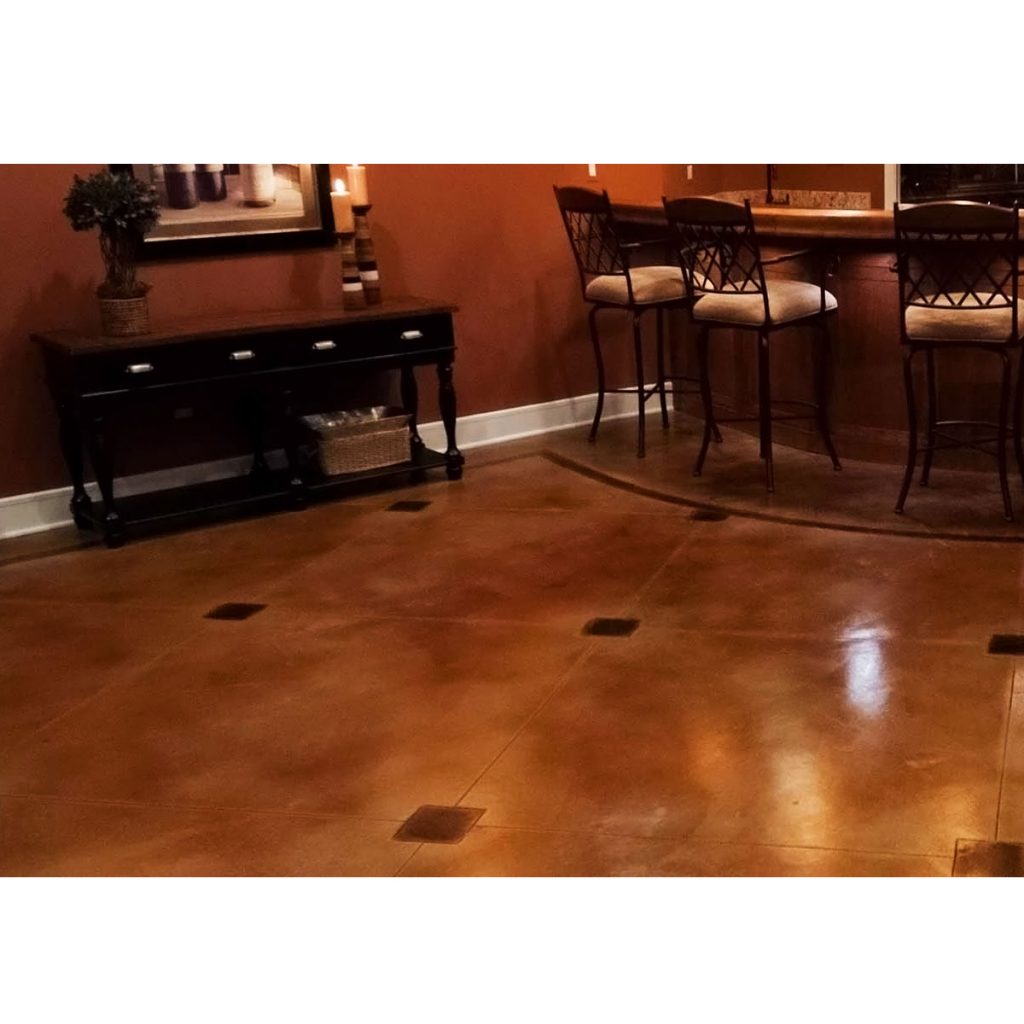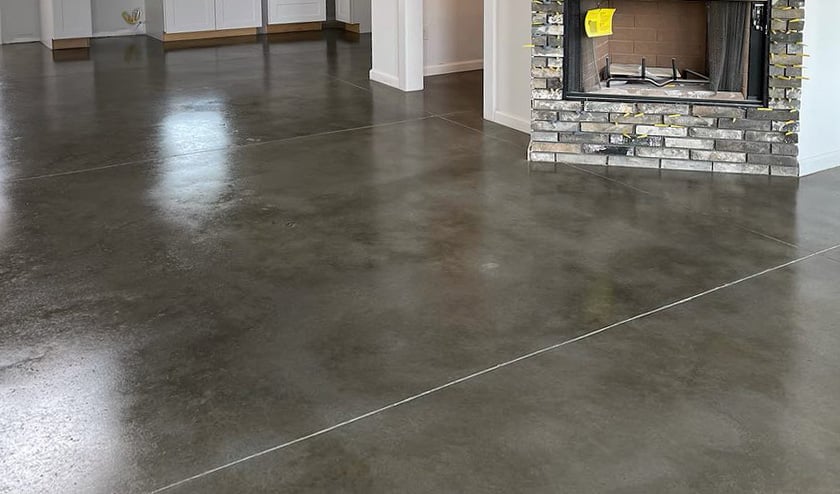Comprehending the Series Of Solutions Offered in Flooring: Highlighting Stained Concrete Techniques
Stained concrete has become an engaging flooring option for numerous rooms. Its convenience exists in the option between acid and water-based stains, each supplying distinctive aesthetic appeals. Appropriate preparation and ongoing maintenance are vital to ensure its sturdiness and appearance. As the need for cutting-edge flooring solutions expands, recognizing the subtleties of stained concrete strategies might open up brand-new opportunities for both household and industrial settings. What distinct advantages might this floor covering choice give a task?
The Fundamentals of Stained Concrete
Stained concrete functions as a flexible flooring alternative that incorporates durability with visual appeal. This floor covering method involves using a particularly developed stain to the concrete surface area, which passes through and modifies the shade of the material. The process not just enhances the appearances of concrete however additionally offers the benefit of shielding it from deterioration. Stained concrete can attain a wide variety of looks, from natural tones to dynamic tones, making it appropriate for various style motifs.
Proper prep work of the concrete surface is essential for excellent results. This might include cleaning, grinding, or etching to assure the stain adheres effectively. On top of that, the application process typically includes utilizing devices such as sprayers or brushes to attain consistent coverage. After staining, a sealer is often used to enhance toughness and keep the vibrancy of the shade. Ultimately, stained concrete offers an appealing and long-lasting flooring service for property and industrial rooms alike.
Types of Stains: Acid vs. Water-Based

In comparison, water-based stains provide a bigger variety of shades and are simpler to use. They do not respond chemically with concrete yet instead give a surface tint - Austin stained concrete company. Water-based stains are reduced in volatile organic compounds (VOCs), making them much more eco-friendly and suitable for interior tasks. While they may not supply the very same deepness of shade as acid stains, their flexibility and convenience of use make them appealing for various applications. Ultimately, the choice depends on the project's requirements, desired aesthetic appeals, and area
Strategies for Staining Concrete
The strategies for staining concrete vary significantly in between acid and water-based techniques. Acid staining entails a chain reaction that creates distinct, variegated colors, while water-based discolorations provide a more comprehensive combination and much easier application. Comprehending these procedures is essential for accomplishing the desired visual in concrete flooring.
Acid Staining Refine
Acid staining uses a dynamic method to boost the aesthetic appeal of concrete surface areas. This procedure entails using a blend of water, hydrochloric acid, and pigments to the concrete, which reacts chemically to produce dynamic, clear colors. Initially, the concrete surface must be completely cleaned up and prepped to guarantee ideal attachment. When applied, the acid stain passes through the concrete, producing distinct marbled effects as it responds with the lime in the concrete. After the desired shade develops, the surface is neutralized and washed to halt the reaction. Finally, a sealant is related to protect the coating and enhance resilience. Acid staining not just transforms the appearance of concrete yet likewise supplies a lasting remedy for decorative floor covering.
Water-Based Staining Advantages
Exactly how can water-based staining boost the aesthetic and useful high qualities of concrete surfaces? Water-based discolorations offer a functional service for boosting concrete, providing vibrant shade options while ensuring ecological safety. Unlike acid discolorations, water-based options penetrate the surface, permitting even color distribution and a series of surfaces, from matte to shiny. Additionally, they are low in unstable natural substances (VOCs), making them less damaging to interior air quality. Their quick drying time assists in quicker job conclusion, while their resistance to fading makes certain lasting appeal. Water-based stains can likewise improve the concrete's durability and resistance to spots, making them an excellent option for both domestic and business applications. Eventually, they give a lasting, eye-catching solution for different concrete surfaces.
Layout Possibilities With Stained Concrete
Stained concrete offers a series of layout opportunities that can boost any type of area. Strategies such as shade variant, different surface ending up choices, and custom-made style patterns permit one-of-a-kind and customized floor covering options. These elements not just boost visual appeals yet additionally add to the total capability of the concrete surface.
Shade Variation Methods
While exploring the design possibilities of stained concrete, color variant strategies play a critical duty in boosting both aesthetic appeal and capability. These strategies permit for the development of unique patterns and impacts that can change an easy concrete surface right into a visually striking aspect of an area. Options such as acid staining, which responds chemically with the concrete, create rich, translucent hues that resemble natural rock. Water-based stains offer a more comprehensive color scheme and enable more control in layout. In addition, layering different discolorations can produce depth and dimension, providing a tailored look. By integrating shade variation strategies, designers can attain diverse designs, from rustic to modern, making sure that discolored concrete fits effortlessly right into any style system.
Surface Finishing Options
The expedition of color variation methods establishes the phase for considering surface ending up options, which greatly influence the general look and capability of discolored concrete. Numerous coatings can boost the visual appeal and longevity of the surface. Common options consist of matte, satin, and shiny coatings, each providing a distinct visual impact. Matte surfaces supply a refined, understated sophistication, while satin finishes strike a balance between sheen and practicality, making them prominent for household and commercial spaces. Shiny coatings, on the other hand, create a high-shine look, enhancing shade vibrancy and light reflection. Additionally, surface treatments such as sprucing up or securing further enhance longevity, making these ending up alternatives important factors to consider in creating practical and visually enticing stained concrete floors.
Custom Layout Patterns
Exactly how can custom-made design patterns boost the allure of stained concrete? By integrating distinct designs, tarnished concrete can change regular flooring right into a striking visual statement. Personalized patterns, such as geometric forms, detailed themes, or organic designs, enable personalization, making rooms feel tailored and welcoming. Customers can select from a range of techniques, including saw cuts, patterns, or overlays, to achieve wanted impacts. Furthermore, integrating multiple colors with numerous stain strategies boosts the depth and measurement of the patterns. These style possibilities not just improve aesthetic allure but additionally enhance the worth of household or industrial rooms. Inevitably, custom-made style patterns provide a chance for imagination, setting discolored concrete in addition to typical flooring choices.
Preparing Your Concrete Surface
Correct prep work of the concrete surface is important for achieving a successful tarnished surface. This process begins with extensive cleaning to remove dirt, grease, and any other impurities. A pressure washer or a flooring scrubber can efficiently get rid of these materials, making sure a tidy slate for staining. After cleaning, it is essential to fix any type of fractures or flaws in the concrete. This can be achieved utilizing a concrete patching compound, which ought to be permitted to heal completely before proceeding.
Once the surface is clean and repaired, grinding or sanding might be required to produce a smooth, even texture. This step enhances the concrete's capability to absorb the stain evenly. A concrete etcher can be applied to open up the pores of the surface, enabling for much better bond of the stain. By adhering to these preparation steps, the resulting discolored concrete will exhibit an extra dynamic and lasting finish
Maintenance and Care for Stained Concrete
Preserving tarnished concrete is vital for protecting its look and durability after the initial preparation and application of stain. Normal cleaning is vital; sweeping or vacuuming to eliminate dust and particles stops scratches and monotony. For deeper cleansing, a moderate pH-neutral detergent blended with water can be made use view publisher site of, followed by comprehensive washing to stay clear of deposit buildup.
Sealing stained concrete is one more vital maintenance step, as it safeguards the surface area from spots and moisture. Depending upon the sealant kind, reapplication may be essential each to three years. In addition, preventing harsh chemicals and rough tools helps preserve the stability of the stain.
For outside discolored concrete, it is recommended to clear snow or ice quickly to avoid damage from freeze-thaw cycles. Overall, constant treatment guarantees that stained concrete preserves its dynamic shade and structural security over her response time, making it a lasting flooring choice.

Cost Considerations for Stained Concrete Flooring
When assessing the expense of discolored concrete flooring, prospective home owners commonly wonder regarding the different aspects that influence pricing. Key factors to consider consist of the size of the area to be covered, the complexity of the design, and the kind of stain utilized. Basic staining strategies often tend to be much more cost effective, while complex patterns or several shades can substantially raise expenses.

Geographical area is another element, as rates can vary extensively from one region to another. Continuous upkeep costs ought to be factored in, as sealers and protective coatings might be essential over time to protect the aesthetic and resilience of the stained concrete.
Regularly Asked Questions
Can Stained Concrete Be Applied Over Existing Floor Covering?
The concern of whether stained concrete can be used over existing floor covering is commonly asked. Commonly, it is possible, offered the underlying surface is clean, steady, and ideal for appropriate attachment of the discolored concrete.
How Lengthy Does the Staining Process Take?
The staining process typically takes a couple of hours to a full day, depending on the size of the area and the intricacy of the layout. Curing might require additional time before the surface is fully functional.
Is Stained Concrete Suitable for Outdoor Usage?
Stained concrete is undoubtedly appropriate for exterior use, as it holds up against various climate condition. Its reference resilience and visual allure make it a popular option for outdoor patios, pathways, and driveways, boosting both functionality and aesthetic passion.
Can I Modification the Shade of Stained Concrete Later On?
The capability to alter the shade of tarnished concrete later depends on different aspects, consisting of the initial stain kind and surface area prep work. Consulting a specialist can offer assistance on prospective choices and outcomes for color modification.
Exist Eco-Friendly Options for Stained Concrete?
The query regarding green alternatives for tarnished concrete discloses a growing interest in lasting structure practices. Lots of business currently use low-VOC stains and eco-friendly sealers, making sure aesthetic charm while lessening environmental impact.